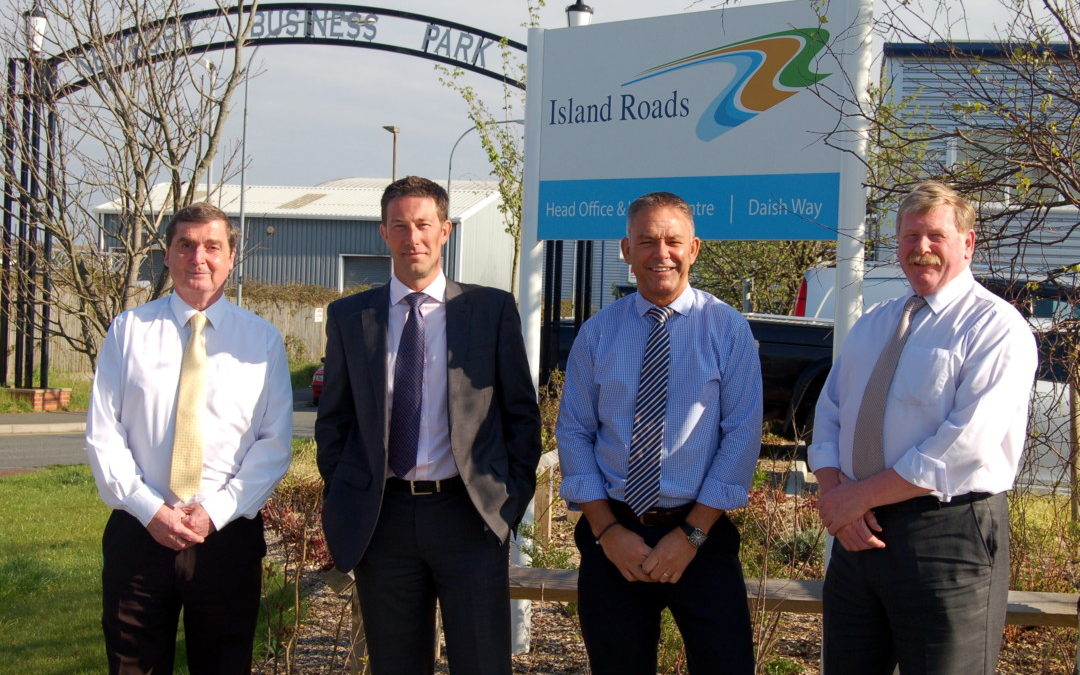Tom Stroud goes behind the scenes at the Island’s PFI contractor
“Island roads are different” is a well worn phrase but in 2014 it’s one that still applies. Since April last year the management and upgrading of our road network has been the responsibility of a different company; Island Roads, no longer the Isle Of Wight Council. The 25 year PFI scheme has now been in place for over a year.
Paul Herbert, Service Director for Ringway Island Roads, explains. “The PFI project is about fence to fence improvement of the Island’s assets from some of the worst in the country to some of the best. It’s been an exciting and challenging first year.”
Island Roads has a headquarters on Daish Way in Newport and a winter maintenance depot at Stag Lane. It isn’t just asphalt and potholes either. The company is also upgrading streetlights and footways and undertaking geotechnical schemes to stabilise some of the worse affected roads on the Island. Kevin Burton, Island Roads Network Manager had worked for the local authority for almost 30 years and describes it as “a complete culture change.”
“We’ve taken on improving circa 98% of the network, including carriageways, drains, streetlights, footpaths, bus shelters and bins. We merged seven partner organisations, TUPEing across a large number of people with varying skillsets and bringing them into a new way of working with an integrated contract that is unique in its format. The amount of training that everybody undertook last year has improved everybody’s skillsets. We’ve been amazed at the passion and commitment of our employees.”
That training equates to around 179,000 hours in the last year. In that time Island Roads has surfaced 160,000 m2 of highway, completing two major and fifteen minor drainage schemes. They have installed over 4,500 new energy-efficient LED street lights and completed one of the largest geotechnical schemes in Bouldnor.
“The PFI contract also looks to promote regeneration on the Island,” explains Paul Herbert. “We actively went out and recruited local people and we’re now running the business with around 200 employees. Our supply chain partners are in the main local contractors and suppliers, who have also benefitted from the increased spend going to Island companies. HSS Hire and Top Mops to name a few have increased their staffing levels to cope with the demand to supply the project.”
For any business the first year presents a huge learning curve. The winter’s extreme weather meant the Island Roads team was constantly battling floods, road closures and fallen trees.
“Things started to turn bad in October with the St Jude storm and we had about nine weeks when it didn’t stop raining,” says Steve Jenkins, Operations Manager for Maintenance. “When the storms arrived on the 23rd December, I had 20 guys who came in even though they were on annual leave. We worked Christmas Day and then the clear-up operation that began on Boxing Day continued until March, including through the Valentine’s Day storms. When I asked the guys to do something, they did it. It’s definitely cost us money but that’s what we do.”
Island Roads is a non-traditional business in that it doesn’t operate commercially. It doesn’t sell a product but at the same time has fixed budgets and is assessed on the standard of its work. Their efforts this winter may have cost them money and time but they have also raised the company’s profile in the community.
“There has been a sea change,” says Paul Herbert. “Residents understand what we have achieved, particularly around Christmas. The weather was unprecedented and we have gone over and beyond what we needed to do within the contract. That’s about commitment to the Island.”
Since April last year the hub has answered over 30,000 enquiries and Island Roads has dealt with over 150 highway emergencies, repaired around 10,000 highway defects and carried out over 25,000 safety inspections. With such a large task, hampered by unpredictable weather, there are bound to be differences of opinion.
The recent closure of the Bouldnor Road drew some complaints from businesses but Keith Gourlay, PFI Construction Manager, says they did their best.
“I think it’s impossible to do a job of that nature and keep everybody happy. We minimised the closure as much as we could. We did the work out of season and we also worked with the utilities companies to co-ordinate their works under our closure. I think we ticked all the right boxes. Our policy is to be open and to co-operate with people. We’ll assist whenever we can.”
Kevin Burton agrees. “I think it’s beyond any doubt that if we hadn’t brought forward the Bouldnor works we might not even have a Yarmouth road any more. We only need to look at the Undercliff as an example of geological instability. The people who were directly affected were actually passionately supportive of everything that we did. The people on the periphery often were the ones complaining.”
Most of the Island-wide improvement works will be undertaken in the first seven years of the PFI contract, referred to as the Core Investment Period. The terms of the PFI mean that the Island is split into six districts, each with a steward who will engage regularly with the community and town and parish councils.
“The contract recognizes that the Island’s largest asset is its natural landscape,” says Kevin Burton. “Tourism is a huge part of the local economy. That’s why our core investment programme runs for 7 years instead of the usual 5. That’s to ensure that any disruption is minimized. An enormous amount of work is now done overnight on the main routes, so we don’t have the disruption of years gone by. We’ve received hundreds of compliments and thanks, much more than in the days of the previous highway authority.”
With year 1 under their belts, the Island Roads team will continue their resurfacing works, from the major routes to the quiet lanes of the Island. “People often focus on potholes,” says Steve Jenkins. “There’s also the street cleansing, the horticulture, the grass cutting, gully cleansing – there are levels of service that we have to maintain. People often don’t recognize this. We have around 130 very important drainage schemes and they mainly go unseen.”
The last year has also been a busy one away from the roads. The team has given safety talks to hundreds of schoolchildren and spoken to 2,000 visitors at their mobile visitor centre. Paul Herbert is also looking to the future.
“We’ve taken on six apprentices aged from 16 to 23 and I am looking to increase this by another two in 2014. They’re all passionate about the business and they are all learning new core skills. We’ve got four graduates and also have a bursary to sponsor graduates through the project. My goal is to retain these skills on the Island. I want residents of the Island who become engineers to stay here and be involved in the project, continue to maintain the assets for years to come and eventually replace me!”
First published in the May 2014 issue of Island Business magazine.





